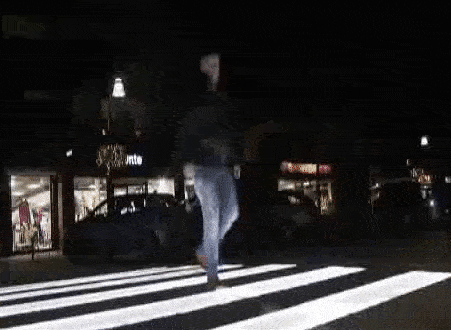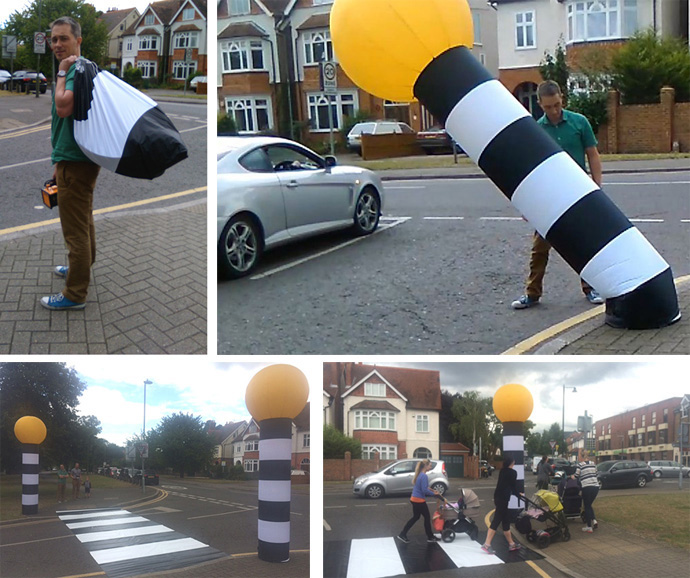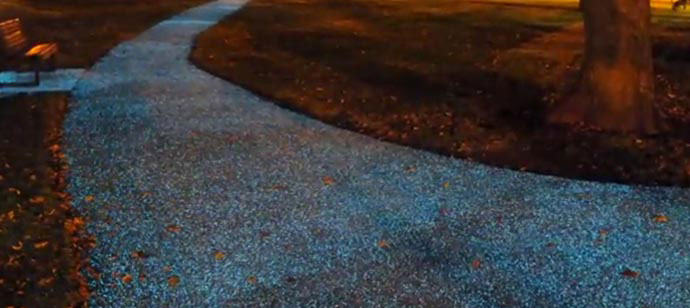
Dutch town Eerbeek has recently become home to the world’s first luminous zebra crossing – a visually distinctive and environmentally friendly way of reducing road danger.
Schools here in Britain that campaign for safe crossings to be installed outside their gates, but are refused on grounds of cost, and which work hard to protect children from road danger on these dark winter evenings, will look at the luminous zebra crossing in awe. In response to the reluctance of local authorities to build safe crossings outside schools, we built our own inflatable zebra crossing – complete with flashing lights.

The luminous zebra crossing uses glow-in-the-dark paint of a kind that has already found application in other types of pathway. Starpath is a surface treatment for paths that absorbs energy from the sun during the day and then releases it at night, causing the particles embedded in the ground to glow like a carpet of stars.
British company Pro-Teq claims Starpath offers an environmentally-friendly alternative to street lighting and that its anti-slip properties make it ideal for use on bike paths.
According to the owner of Pro-Teq Surfacing, Hamish Scott: “There is nothing like Starpath in the world, this product adjusts to the natural light, so if it is pitch black outside the luminous natural earth enhances, and if the sky is lighter, it won’t release as much luminosity – it adjusts accordingly.”
Starpath can be quickly and easily applied to existing paths – a 150 m stretch currently being trialled in Cambridge was installed and ready to use in less than five hours.
If the glow from a luminous zebra crossing or cycle lane proves insufficient, trees with naturally-glowing leaves could soon illuminate streets without without the need for conventional street lamps. Researchers in Taiwan have discovered that the addition of gold nanoparticles to the leaves of the Bacopa Caroliniana tree causes them to glow. The glowing plants reduce light pollution while at the same time absorbing CO2.

Glowing trees could be for life, not just for Christmas
Dr Yen-Hsun Su at Taiwan’s Cheng Kung University told Chemistry World: “In the future, bio-LED could be used to make roadside trees luminescent at night. This will save energy and absorb CO2 as the bio-LED luminescence will cause the chloroplast to conduct photosynthesis.”
Would the last driver to go to sleep please turn out the lights?
With a pressing need for us all to reduce energy consumption, the time has come to question why so many lights are left on. Office buildings in cities routinely leave lights on overnight and many street lamps remain on through the small hours. Where street lighting is concerned, we take a one-size-fits-all approach, but the needs of pedestrians and motorists are different. If organisations responsible for lighting, as part of their planned maintenance and replacement programmes, devised provision for driving and walking separately, they would be able to turn off the lights for drivers, but keep on the lower-powered lights for pedestrians. Naturally, this would generally only apply to main roads, but the savings in energy would be worthwhile. In some cases, the luminous zebra crossing, glow-in-the-dark paths and even bioluminescent trees could play a role.
Your journey. Our world
The Environmental Transport Association was established in 1990 as an ethical provider of green, reliable travel services.
Twenty-six years later, we continue to put concern for our environment at the heart of all we do. We have been applying the highest ethical and environmental standards to our business since 1990 – long before corporate social responsibility became a buzzword – but don’t take our word for it. Beating household-name insurance companies such as John Lewis and the Co-op, we have been named ethical in Britain by the Good Shopping Guide.
Find out more about our cycle insurance, breakdown cover and travel insurance.

0 Comments View now